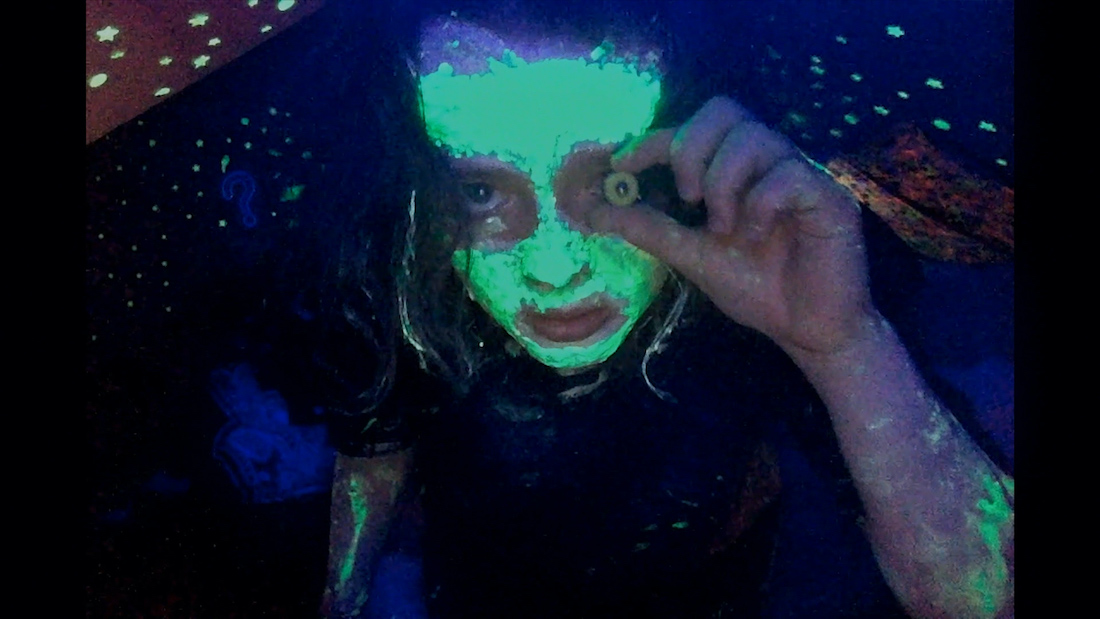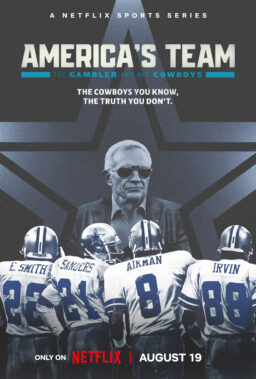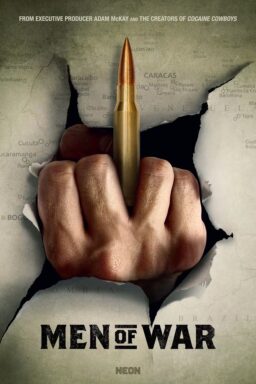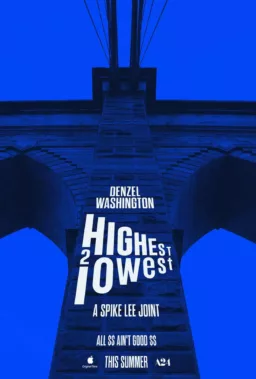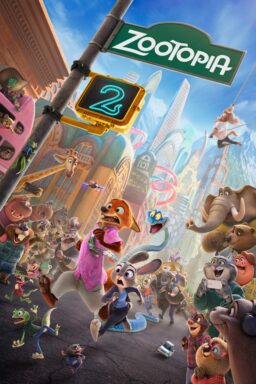There are many films about the internet and its effects, but so few seem to capture what it’s like being on the internet—staring at the screen, silent, maybe sitting in darkness, searching for something, probably what you’re doing right now. It’s a lonely place. Writer/director Jane Schoenbrun’s “We’re All Going to the World’s Fair” captures this experience with the story of a shy teen girl named Casey (Anna Cobb in an incredible first movie role), who is caught up in a spooky transformational online game called the “World’s Fair.” Is it real? Does she change after going through its incantations? An older man under the Skype handle JLB (Michael J. Rogers), reaches out to her after studying videos she has made to document her process. Meanwhile, Anna studies videos of other people who have played the game, or claim to, and her algorithm goes from one anonymous experience to the next with a meditative rhythm.
“We’re All Going to the World’s Fair” is a particularly perfect film to watch completely alone. But the influences on Schoenbrun’s movie from the likes of Chantal Akerman, David Lynch, and Tsai Ming-Liang emphasize the gripping part of an in-cinema experience, in which one watches its characters for a long time to get lost in their sense of space. Or in this case, the internet. “We’re All Going to the World’s Fair” challenges what a film filled with characters staring at computers can look like and feel like, along with the binary of cinematic and storytelling language. It concerns the internal and external experience, especially when the internet will always be a great unknown.
In their directors statement for the film, Schoenbrun quotes critic Willow Maclay about dysphoria in the case of transgender cinema, and adds their own note: “I hope certain viewers will see something they recognize in these feelings and images … in its interior world and emotional turbulence … in its hazy aesthetic distortion and oneiric reflections on gendered bodies, ungendered bodies, and bodies in disarray. In its cinematic dysphoria. I hope it will make them feel a little less alone.”
Schoenbrun spoke to RogerEbert.com about the making of “We’re All Going to the World’s Fair,” the inspiration it takes from slow cinema, the secrets behind Anna Cobb’s incredible breakout performance, Schoenbrun’s future plans with horror, and more.
When you were making this film, what was the ideal way you imagined people would watch it?
I was definitely thinking about theatrical. While we were making it, I think I was acutely aware of how much the movie is asking of the viewers, especially American viewers who are maybe not as big fans of like, Abbas Kiarostami or Tsai Ming-Liang or something like that. The movie moves at a pretty slow tempo, and this was a very early decision because I think the movie is, as much as the movie is about aloneness and being in this solitary state, it’s also a movie that’s trying to capture boredom. So it has to be a little boring.
One for the primary references I was looking at was “Je Tu Il Elle” by Chantal Akerman, especially the beginning of that movie, there’s a 30-minute sequence of her just rotting away in her room, alone. And the question of how to make a movie that allows for that experience, I think I was just really aware that people these days, and I include myself in this assessment, are much more likely to give themselves to that kind of slow tempo in a movie theater, where there are no other distractions at home. And especially some of these slow cinema-inspired moments in the film that are almost trying to evoke a trance state, felt really important to me that audiences be immersed as much as possible. When we’re watching Casey walk through the snow for three minutes straight, I think if you can really give yourself to the sound of the footprints in the snow, in a movie theater, you’ll be able to tap into the film in this dream-like wavelength.
But it seems like slow cinema helps you understand how you want this meditative aspect to happen with the videos, where you go from the next video to the next video. It’s the YouTube algorithm slow cinema.
I think all of my favorite films evoke this transportation, they transport you to another state. I have this vivid memory of going to see Kelly Reichardt’s “Certain Women” right around Trump getting elected. I think like a lot of people I was reloading Twitter, waiting for the world to end, and I just remember walking into that movie and the sense of calming washing over me as I gave myself to like the grain of the film and the pace of the film, the way the film was saying to me, “Slow down, you’re not going to be able to interact with a lot of the tones and emotions that I want to be expressing. Unless you’re able to meet me at a slower tempo.” I think that’s done in the cinema. And that was the goal of the film, not to slow it down to be confrontational, but I think you can evoke a lot more. I think so many American films are so conservative in form and language, almost television way, because we are constantly looking for some stimulation, or watching for something to go to the next thing, the next scene. The twist in the post-credits sequence.
I had this motto on set: “Let’s stare at the flame.” I forget what book I read it in, but some philosopher I like used this metaphor of a lighter. You can light a lighter to light your stove, to make yourself a cup of tea. And this is a worthy pursuit. But the lighter is being used as just potential energy toward something else. Or you can light a lighter and just stare at the flame and appreciate the beauty and strangeness of fire, and appreciate it there in front of you. To check myself as much as anyone, when I’m directing a scene, that I’m staring at the flame and not just pushing the film along to the next moment. Far too many American films are trying to make a cup of tea the whole damn movie.

I was struck watching the first sequence again—that scene is about staring at the flame. Did you have to build up to that courage with Anna, to rely on her talent, to make that happen?
We nailed that in one take; I think you’re looking at take three, maybe. It was also the second day of production. And I was a little nervous because Anna had never acted in a feature before, and you never know how someone is going to perform with even a small crew, but a 15-person crew looking on. But I also wasn’t surprised, because we had done months and months of prep. We had run that scene many, many times before, with a camera setup in our production office, and Anna playing out each beat. Her dedication to work ethic and craft is insane, she’s also extraordinarily talented. But a factor of that talent is this ability to be ready for that first take. She was both incredibly present, but every facial tic and movement memorized.
There are whole scenes of the film that are fully Anna’s. The tarot card scene most notably is full improvisation, but our cursed images of Anna holding the eye up to her eye, that traveled with the film a lot, that was improvisation on the first take. I think she just felt it and approached the camera, to show us the idea, but the idea of her wearing the eye. I think Anna and I work from this similar rubric of obsessively overplanning everything, that when we get there the idea of inviting something new in a very present way can be integrated without breaking the film.
I was also struck by what you wrote in your director’s statement about dysphoria, and how it relates to the film’s idea of aloneness. Did you talk to Anna and Michael about these ideas while making the film?
We didn’t talk about dysphoria. This was sort of there for me, but we talked a ton about identity and desire. And desire is this thing that I think is missing from portrayals of the internet in a really key way. We see a million films about how the internet is a scary place that is corrupting the youth, but what a lot of these films don’t seem to be interested in is why people invented the internet, or why kids are using the internet. Which I think is the hidden question of this film: “What’s driving these characters to be in this space?”
And for Anna, who doesn’t like horror movies, she doesn’t use the internet very much. It was very foreign to her in some ways and very relatable to her in other ways. She certainly understood what it was like to feel disconnected from yourself as a teenager, and she certainly understood the idea of being drawn to darker spaces because they were providing you some kind of comfort. But her question to me was, “Why is Casey doing this?” and it took me months to articulate the answer to her, and it wasn’t a one-sentence answer. It was something that we found through the exploration of character and their desire to be in that space.
Did that pull your movie together, answering her question like that? Especially with what originally inspired you with the film?
I think it always helps pull the movie together when you’re forced to put into words something that feels intuitive to you. I take a lot of pleasure in that process, actually, I think it’s a very important part of directing. Once you open the script up to others, to invite them to bring this thing to life, your job becomes Vibe Checker. I’m simply trying to get everyone to see and feel and understand kind of walk through the atmosphere that I’m walking through in making the film. Sometimes that can turn into an intellectual conversation about theory and what this all means, but sometimes it can be things that I know intuitively and were there for me in the script, like what being 15 on the internet in 2001 felt like. But I think the film, if it works, is 85 minutes that can stand alone and evoke that atmosphere and a lot of the ideas and emotions that are lurking as specters behind the movie.

And when you mentioned desire, with your own experience on the internet, it is curious how you thread the needle about the older man befriending a young girl on the internet. Was that one of the trickier components to get right?
It was definitely something I was hyper conscious of. I think the film is not interested in binaries, period. There’s nothing less interesting to me than making a film about stranger danger on the internet, where there’s our cliche idea of the shadowy pedophile. We’ve seen that, we understand that, all that could possibly do is give people an opportunity to shake their finger and then walk away feeling proud of themselves.
I was reading, this is gonna sound really pretentious, Gilles Deleuze on cinema recently. He was talking about, and you know it’s an older idea, about representation, which I think something he was writing about in the late ‘80s was very different from what it means now. But this idea that the way we represent things in films, when we represent them externally, we can lose a lot of complexity. Meaning, there’s a good guy and a bad guy. This is the way films are structured, most characters can stand in and represent one thing diametrically opposed to the other things in the work. That’s the hero, that’s the villain. And of course with Anna on the internet, and Michael on the internet, there’s a very obvious hero/villain to be drawn, and not an inaccurate one. But one that we are immediately drawn to.
Deluze talks about being more interested in a film in a way to unpack internal contradictions, the way in which one character or one person can be both hero and villain, at different moments. Not just that binary dichotomy, but a million other spectrums of complexity. I think Casey is certainly this, we see so many different sides of this character and them in situations, and hopefully all kind of adds up to for a not simple, and very emotionally complex and contradictory character that feels real in the way it is complex and contradictory. I think I’m looking for a similar thing in Michael, not to like, find the humanity in a pedophile, but to express the ambivalence of so many online relationships, and how that guy probably doesn’t understand what he’s looking for there.
I think this is all encapsulated in the first moment he appears on screen. There’s this reveal of him on the other side of the computer screen. It so easily could have turned into this pulling back the curtain on the monstrous man staring at the computer, and I went out of my way to subvert that. For it to feel like a lot more from ambivalent, even the gaze on this person is ambivalent. And I think that’s part of the film not letting you off the hook for having to ask yourself questions about your gaze on that character.
The drawing that JLB uses to represent himself on Skype … I always find myself looking into his eyes.
Another wonderful “looking at the flame” moment, one of the people who worked on the film, and they’ve asked to remain anonymous, a couple days into shooting they sat down with me at the breakfast table like, “Hey, what’s your relationship with Creepypasta?” And I said, “Well, I’ve read my fair share and I’m making a movie about it,” and this person said “When I was in high school, I would draw them.” And this person is actually the anonymous creator of one of the most famous Creepypastas, which is that drawing, which is called “Unwanted Houseguest.” Which sort of saturated on the internet in a way similar to the other Creepypastas that this movie is drawn from.

I’m curious what horror means to you, as you were writing stories online as a teenager, and now you have bits of body horror in your film. Are you thinking about horror as something you want to be part of your expression as a filmmaker?
Yeah, I think it’s always going to be a paint on the paintbrush, at the very least. I think with this film in particular, and a lot of the works I’m interested in making, the relationship will continue to be not exactly straightforward. I think I’m really interested in the question of “What is horror?” Does “Mulholland Drive” get that tag? Does “Videodrome”? I think a lot of my favorite films are interested in dark tones. And with Lynch especially, I think the way he plays with genres is so fascinating. I think about how “Lost Highway” is so consciously riffing on horror in certain moments, and then will also have this really complicated relationship with gangster pictures. It feels like it’s not interested in skewing into one genre, but of borrowing and understanding the power of various genres. The way you can smush them together, to elicit responses from audiences.
And I think my film is interested in that, like Lynch’s work, this sort of spectrum of performance. The body horror moment in my film in a shower, is something that I do know people wince at, but is also something I didn’t want to feel like the most realistic moment in the film. To me, that section in the film is all about challenging your perception of how real anything that’s happening in the film is. When we return to Casey and she starts living or performing or being possessed by what feels like this visceral scary things, there might be a voice in the back of our head that might say, “Wait, but I just saw this kid get pulled into a computer by a ghost, I’m sure that wasn’t real.”
I think my films will continue to be really interested in this. The next one especially. First of all, there are monsters in it, we’re building monsters, which is pretty sick, pretty fun. But I think the relationship the film will have with those monsters is sort of like, an understanding of horror where creating different modes and planes of realism and reality and fiction and genre and playing with those elements against each other, to get at points that you want to get at emotionally. It’s much more exciting to me than making a movie about someone being possessed and there are monsters coming to get her or something.
That comes back to cinematic language creating its binary, of genre, character.
It’s like cinematic mad libs. Why would I want to spend three years of my life doing, “I’ve watched this movie before, I know what happens”?
Or that we know there are heroes and villains.
Yeah, or that the horror is “x.” I think this is me reflecting on, especially with this film obviously, dysphoria, and the experience—not the trans experience—the experience of being repressed and trans in a time and place and a body that has no language or understanding for what it is experiencing. That is a very ambiguous, ephemeral, feeling and a sort of strange horror that I don’t think it’s easy to just wrap up in some metaphor, or some monster that represents it. Or even some emotional state that represents it. I think we as trans filmmakers are looking for cinematic language to express that ambiguity, whether it be like the simulacra of “The Matrix” or the body horror of Cronenberg, or the liminal space of Lynch.
“We’re All Going to the World’s Fair” is now playing in theaters and available on digital platforms on April 22nd.

